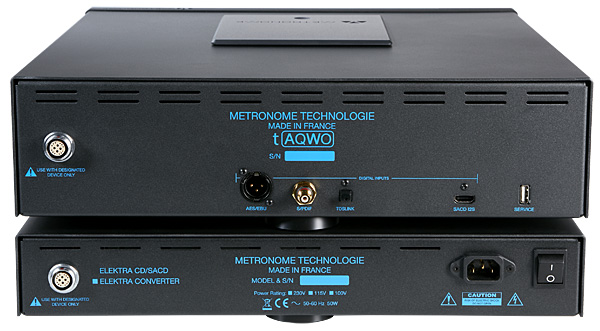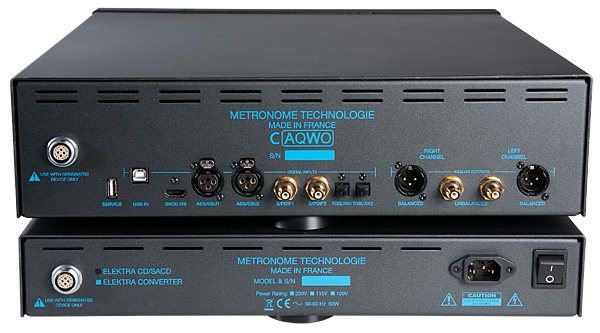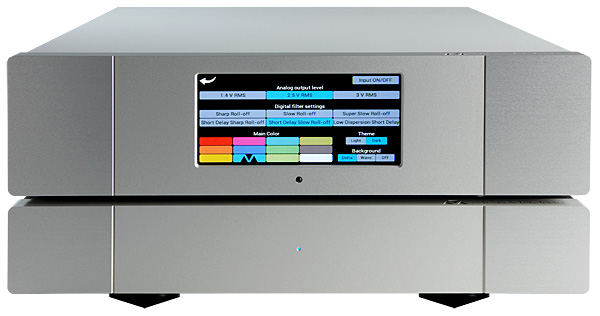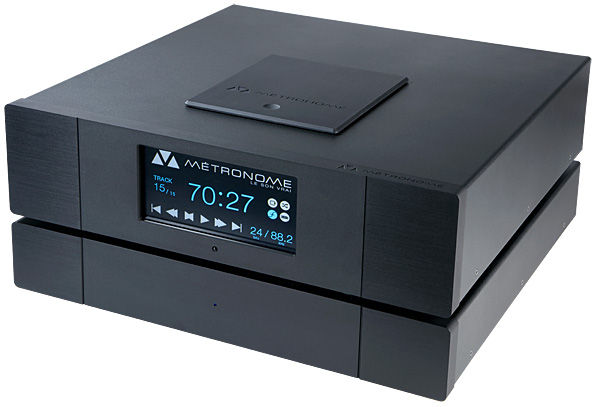| Columns Retired Columns & Blogs |
That slow roll-off filter along with the tube output stage should sound good with CDs :-) .........
The top-loading t|AQWO transport offers optional upsampling, but the c|AQWO is, in Clauzel's words, a "pure" DAC with no upsampling features. Because the DAC's two Japanese-sourced AKM AK4497 chips (one per channel) are capable of upsampling, and can decode up to PCM 32/768 or DSD512 (8×DSD), I asked Clauzel why he nixed upsampling in the DAC.

"We could have easily put an [upsampling] module in the c|AQWO as well as the t|AQWO," he acknowledged by email. "It's my personal choice to implement the function only in the transport, and to limit data in the D/A converter to the format in which it enters. My way of thinking is that in the DAC box, nothing should happen other than signal conversion from digital to analog."
The c|AQWO offers the option to process its signal through two Philips NOS JAN 6922 tubes for those desiring what Clauzel described as a "quite neutral" tube-like effect. "I like tubes when their effects are nice and delicate," he said. "I've kept the difference between the two outputs slight because I don't want to have a cathedral effect or something that strong. If customers want a stronger tube effect, they are of course allowed to change the tubes." To engage the tube output stage, users depress a small tube icon on the lower left of the DAC's touch-screen display.
The c|AQWO lacks streaming features, is not a Roon endpoint, and does not decode or render MQA. About MQA, Clauzel said, "I think MQA is mostly important for streaming and network playing. Our streamers do it, but for a top-of-the-range converter, the quality is so high that I ask, 'Why MQA? Why should we use a codec that creates smaller files when our processors can easily handle the large files?' Maybe I'm wrong, but this is my way of thinking. I don't think MQA would make very much difference on our top-of-the-line products."

In addition to HDMI I2S, the c|AQWO has USB, AES/EBU, S/PDIF, and optical inputs. There's no Ethernet port, but that seems to be the case with many DACs, including the EMM Labs DV2, that were not designed to serve as streamers. Only the c|AQWO's USB and HDMI ports can process PCM sampling rates above 192kHz or DSD. I try to avoid using computers in my reviews because they are so sonically compromised, and the only music server/ streamer I own is the Roon Nucleus+. So, when streaming, I sent signal via Ethernet from the Nucleus+ to the dCS Network Bridge ($4750), which is a Roon endpoint and MQA decoder. From there, I used AES/EBU to send it to the c|AQWO. I tried both AES/EBU and S/PDIF, heard virtually no difference, and stuck with AES/EBU because it may be quieter.
The AQWO units' large touchscreen displays, which dominate their front panels, offer a choice of 11 different display colors in either "light" or "dark" theme. In addition to all the PCM and DSD upsampling options in the transport, there's a choice of six digital filters in the DAC. None of these features is accessible by the simple remote, which even lacks a program feature for the transport. Thankfully, the displays are far easier to discern from a distance than the art in the great museums of Paris, which is frequently blocked by gawking tourists who seem to think that selfies, rather than art and music, are the end-all/be-all of human existence. The displays are also far more responsive to input, which means that you won't be tempted to pick them up and throw them across the room.
Both the t|AQWO and c|AQWO are fed by their own versions of Métronome's Elektra outboard power supplies, which connect via long umbilical cords (included). The two power supplies may weigh and look the same, but their internals are different. The t|AQWO's contains three toroidal transformers with Schaffner filters and seven independent regulation lines, while the c|AQWO's supply holds four toroidal transformers with 11 independent regulation lines. Because their umbilical cords are identical, I took care to never mix them up.
Listening choices, conundrums, and joys
Because the manuals for the t|AQWO and c|AQWO were pretty rudimentary, and the products were so new that little else was available online, Wong visited to help with installation. With only two free shelves on my Grand Prix Monza eight-shelf double rack, stacking the transport and DAC atop their respective power supplies was unavoidable. As much as I wished to decouple units, power supplies and shelves, using Grand Prix Apex isolation/dissipation footers with the t|AQWO and/or its power supply would not have left enough room to access the transport's top-loading mechanism. I could easily fit three footers between the c|AQWO and its power supply, but I initially thought that placing a second set between power supply and shelf would have raised the DAC so close to the shelf above that its tubes would have lacked sufficient space for ventilation. So, where I had hoped to use four sets of footers, I made do with only one.

It was only after I began enough listening tests to drive many an audiophile batty—even before Clauzel emailed to say that if stacking components was unavoidable, he advised that one "put decoupling equipment under and in between the boxes"—that I squeezed a second set of footers under the DAC's power supply.
The c|AQWO offers a choice of three analog output levels: 1.4V RMS, 2.5V and 3V RMS. In my system, 2.5 and 3V were the best match for the output levels of the dCS Rossini and EMM Labs DV2 DACs, facilitating the easiest comparisons.
Both the c|AQWO and Rossini DACs offer a choice of up to six PCM digital filters; the DV2 makes matters simple by choosing filters automatically. To my ears, the c|AQWO's "Slow Roll-off" and "Super Slow Roll-off" filters sounded most like the F2 and F3 filters that I customarily use on the Rossini for 24/96 PCM file playback. "Super Slow Roll-Off" was the sharpest-edged of the bunch, and perfect for recordings that otherwise sounded a bit flat. I loved the extra sense of space that the "Low Dispersion Short Delay" filter brought to Finnish composer Kaija Saariaho's Ciel d'hiver (Winter Sky), from her collection True Fire • Ciel d'hiver • Trans (ODE1309, 24/48 FLAC). With this filter, the c|AQWO produced such an extraordinary sense of air, depth, and spaciness that I felt suspended in a vast multi-dimensional alternate reality. But as cool as the filter sounded on Saariaho's uniquely celestial and radiant music, it ultimately felt artificial on more grounded music by a guy named Beethoven.
Since only HDMI I2S allowed me to send the DSD layer from the hi-rez layer of an SACD to the c|AQWO, I used that cable exclusively for disc playback. Upsampling decisions in the t|AQWO were less clear-cut. To maintain consistency during comparison with the Rossini transport, which upsamples PCM to either DXD, DSD, or DSD×2 (DSD128), I stuck with my preference for the Rossini, which is PCM upsampling to DXD (24/352.8). Since the Rossini leaves the DSD layer of an SACD alone, I didn't mess with DSD in the t|AQWO, either.
I spent quite some time evaluating the c|AQWO with and without its 6922 tubes in the signal path. Deciding which I preferred was tough. Using solid-state to play the "Chicago, 2012" movement from Mason Bates's Alternative Energy, as performed by the San Francisco Symphony and Michael Tilson Thomas on the Jack Vad-engineered hybrid SACD, Mason Bates: Works for Orchestra (SFS Media 0065), bass was excellent, midrange superb, air and atmosphere quite good, and the soundstage maximally wall-to-wall. Layered sounds of FermiLab's particle collider zooming back and forth beyond my speakers were quite exciting, the low grunts just what some demented doctor ordered, and the dance music as rhythmically engaging as it was musically absurd.
When I switched the c|AQWO from solid-state to tube, there was a difference. Tonal balance didn't change significantly, but the tubes' gentle kiss of warmth and roundness seemed accompanied by a modest diminution of bass slam and less response in the lower octaves. Even with music devoid of deep bass, such as Murray Perahia's performance, on piano, of Handel's Harpsichord Suite in E, HWV 430 from Murray Perahia Plays Handel and Scarlatti (CD, Sony Classical 62785), I felt the choice was between extra bloom and fullness in the lower octaves. Personally, I love strong but not overblown "tell it like it is" bass, but I fully understand why others will love the tube option.
As I continued to listen and go back and forth between the c|AQWO and my reference DACs, I began to get a sense of the Métronome DAC's unique sound. On "Singing Winds, Crying Beasts" from the MoFi Ultradisc UHR hybrid SACD remastering of Santana's Abraxas (UD-SACD2152), the DAC's huge soundstage and wall-to-wall three-dimensionality were positively thrilling. When multiple instruments got going at once, I also discovered that the Métronome gear prioritizes warmth and smoothness over the extraction of every last detail on a disc or in a digital file.

Sticking with file playback allowed me to easily compare all three DACs. I began with the "Ninth of January" movement from Shostakovich's devastating Symphony No.11, "The Year 1905," as performed live by Andris Nelsons and the Boston Symphony Orchestra (24-bit/96kHz download, Deutsche Grammophon 002859502). The Roon software that I regularly use on my Nucleus+ server/streamer gives this recording a very high dynamic-range rating of 24, which is unmissable when the music shockingly shifts from depicting a heavily percussive fff total assault of gunfire to a near-silent landscape littered with dead bodies. Using the c|AQWO to play both this movement and the title track of Genesis's The Lamb Lies Down on Broadway (Tidal 16/44.1, 2007 stereo mix)—one of Clauzel's favorite albums—what impressed most were not individual details, but rather the collective impact of multiple instruments and musicians playing full out.
Guided by Clauzel's love of Queen, I turned to the title track of Freddie Mercury's over-the-top collaboration with soprano Montserrat Caballé, Barcelona (Tidal 24/48 MQA, 2011 remaster). I know this fabulously campy recording quite well and was drawn most to the warmth the c|AQWO brought to Caballé's voice. The newly upgraded EMM Labs DV2, on the other hand, was far less concerned with tonal glow than delivering the most nuanced, layered, and impactful bass of all three DACs in my system. On the Shostakovich, Genesis, and Freddie Mercury tracks, as well as the first movement from the San Francisco Symphony's digital-only release of Alban Berg's Three Pieces for Orchestra (24/192 WAV, SFS Media SFS0070), the DV2 was the low-end champ.
As I continued to audition the Métronome AQWO front end with a wide range of music—from Rickie Lee Jones's positively weird, crackly-voiced cover of the Rolling Stones' "Sympathy for the Devil" (Tidal, 16/44.1 FLAC), from her album The Devil You Know, to music that addressed far more celestial concerns, such as soprano Elly Ameling's rendition of Schubert's "Die Sterne" (The Stars), from the anthology The Art of Elly Ameling (4 CDs, Philips 473 451-2), the c|AQWO's unique strengths and tonal balance became increasingly clear. It was definitely the most "impressionistic" of the DACs I had in my system, with a nonfatiguing, easy-on-the-ears sound that some would consider analog-like and others would liken to a farther-from-the-stage experience. Emphasizing smoothness and roundness above all, its beauty and musicality were unmissable.
Conclusion
"My target is always to make people forget that they're listening to digital files," Clauzel told me the morning after the units were installed. "Some digital equipment is so detailed and so cold; it's not warm enough and not musical enough. We want a very different product, even if it has imperfections. ... I prefer something that may have imperfections, but that excels in quality, musicality, and an analog feel."
Without question, Métronome's top-of-the-line t|AQWO upsampling/resampling transport and c|AQWO DAC achieve the company's goals. If you're looking for an excellent transport and DAC, by all means make the effort to spend some time with the AQWO front end. With optimal setup, they may very well deliver the sound you long for.

That slow roll-off filter along with the tube output stage should sound good with CDs :-) .........

Metronome Kalista DreamPlay Super Slow roll-off filter also shows similar roll-off on CDs :-) ........

If tube output stage is desired, less expensive iFi Audio Pro iDSD DAC ($2,500, reviewed by Stereophile), could be considered :-) .......

If you want something (kinda) more portable, you could look into Sony DMP-Z1, reviewed by Stereophile ......... It has multiple filters including, slow and super slow roll-off filters :-) .......

pretty sure JVS never goes to big "arena" shows for pop/rock music, and clearly doesn't know much/anyting about live sound reinforcement. That's cool (I know you're primarily an acoustic music guy), but don't try to speak to what you don't know.
Oh, and room/speakers/stage volume will have significantly more effect on the sound than the amps, which have pretty much zero audible effect on the sound. Everyone uses the same few brands (Crown, QSC,etc) of class D amps these days. it's more important for the mics to have good off axis rejection and durability than to be "great" mics. that's why it's mostly dynamic mics that you'll see for live sound regardless of venue size.

those concerts include a Grateful Dead Chinese New Year's Show, sitting / standing / dancing in the exact place where all the speakers converged in the Oakland Coliseum - thank you, friends at Pro Home Systems in Oakland, for getting there at 10 AM to snare the sweet spot - the Rolling Stones in I forget which venue, and a number of amplified operas and concerts in Davies Symphony Hall. Way back, I stood 50 feet from Janis Joplin during an impromptu concert in the main park in St. Louis - one of the most memorable experiences of my life - but the volume was turned down on purpose. Oh, and Patti Labelle and the Bluebells in Oakland's Paramount Theatre. Regardless, glad I brought a smile to your face.

JVS may like the Aurender A30, reviewed by Hi-Fi News ........ It has 7 different filters, including NOS type, slow and super slow roll-off filters :-) ........

JVS could review the latest LG V50, 5G smartphone :-) .......

...... excels in quality, musicality, and an analog feel." quoted Jason Serinus.
All roads lead to Rome.
I enjoy the "imperfections" of vinyl (1000+ LPs 95% classical music) for its "quality, musicality & an analogue feel" withOUT need of spending USD50,000 for the medium players.
vinyl, something imperfect, yet 100% analogue without going through the
tedious imperfect analogue-digital-analogue conversion.
Listening is believing
Jack L
Canada